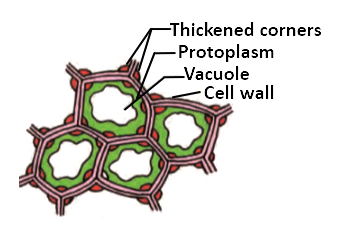Select Question Set:
Assertion(A): The vascular bundles of dicot stems are called open vascular bundles.
Reason(R): Dicot stems can make secondary xylem and secondary phloem with the help of cambium.
Choices for Assertions and reasons:
1. Both (A) and (R) are true and (R) is the correct explanation of (A).
2. Both (A) and (R) are true, but (R) is not the correct explanation of (A).
3. (A) is true, but (R) is false.
4. (A) is false, but (R) is true.
Subtopic: Vascular Tissue System |
82%
From NCERT
Please attempt this question first.
Hints
Please attempt this question first.
Assertion(A): Dicotyledonous stems possess the ability to form secondary xylem and phloem tissues.
Reason(R): In dicotyledonous stems, cambium is present between pericycle and xylem.
Choices for Assertions and reasons:
1. Both (A) and (R) are true and (R) is the correct explanation of (A).
2. Both (A) and (R) are true, but (R) is not the correct explanation of (A).
3. (A) is true, but (R) is false.
4. (A) is false, but (R) is true.
Reason(R): In dicotyledonous stems, cambium is present between pericycle and xylem.
Choices for Assertions and reasons:
1. Both (A) and (R) are true and (R) is the correct explanation of (A).
2. Both (A) and (R) are true, but (R) is not the correct explanation of (A).
3. (A) is true, but (R) is false.
4. (A) is false, but (R) is true.
Subtopic: Dicot Stem |
67%
From NCERT
Please attempt this question first.
Hints
Please attempt this question first.
Assertion(A): The meristematic tissue called cork cambium or phellogen develops in the cortex region of monocot stems.
Reason(R): The activity of vascular cambium causes the shedding of cortical and epidermis layers in the dicot stem.
Choices for Assertions and reasons:
1. Both (A) and (R) are true and (R) is the correct explanation of (A).
2. Both (A) and (R) are true, but (R) is not the correct explanation of (A).
3. (A) is true, but (R) is false.
4. (A) is false, but (R) is true.
Reason(R): The activity of vascular cambium causes the shedding of cortical and epidermis layers in the dicot stem.
Choices for Assertions and reasons:
1. Both (A) and (R) are true and (R) is the correct explanation of (A).
2. Both (A) and (R) are true, but (R) is not the correct explanation of (A).
3. (A) is true, but (R) is false.
4. (A) is false, but (R) is true.
Subtopic: Activity of Vascular Cambium (OLD NCERT) | Activity of Cork Cambium |
70%
From NCERT
Please attempt this question first.
Hints
Please attempt this question first.
Assertion(A): Monocotyledonous stems do not possess the ability to form secondary xylem and phloem tissues.
Reason(R): In monocotyledonous stems, cambium is present.
1. Both (A) and (R) are true and (R) is the correct explanation of (A).
2. Both (A) and (R) are true, but (R) is not the correct explanation of (A).
3. (A) is true, but (R) is false.
4. (A) is false, but (R) is true.
Reason(R): In monocotyledonous stems, cambium is present.
1. Both (A) and (R) are true and (R) is the correct explanation of (A).
2. Both (A) and (R) are true, but (R) is not the correct explanation of (A).
3. (A) is true, but (R) is false.
4. (A) is false, but (R) is true.
Subtopic: Vascular Tissue System |
87%
From NCERT
Please attempt this question first.
Hints
Please attempt this question first.
| Assertion (A): | Suberization leads to death of cell |
| Reason (R): | Suberin is water resistant material. |
| 1. | Both (A) and (R) are True and (R) is the correct explanation of (A). |
| 2. | Both (A) and (R) are True but (R) is not the correct explanation of (A). |
| 3. | (A) is True but (R) is False. |
| 4. | Both (A) and (R) are False. |
Subtopic: Anatomy of Root |
58%
Please attempt this question first.
Hints
Please attempt this question first.
Transverse section of a plant part shows conjoint and open vascular bundles. The transverse section is of:
1. monocot root
2. monocot stem
3. dicot root
4. dicot stem
1. monocot root
2. monocot stem
3. dicot root
4. dicot stem
Subtopic: Dicot Stem |
83%
From NCERT
Please attempt this question first.
Hints
Please attempt this question first.
The alternate terms used for ‘Phellogen’ and ‘Phellem’ respectively are:
| 1. | cork and cork cambium |
| 2. | cork cambium and cork |
| 3. | secondary cortex and cork |
| 4. | cork and secondary cortex |
Subtopic: Activity of Cork Cambium |
77%
From NCERT
Please attempt this question first.
Hints
Please attempt this question first.
In a plant, the protoxylem lies next to the phloem. This arrangement of xylem will be called:
1. Stelar
2. Extrastelar
3. Endarch
4. Exarch
1. Stelar
2. Extrastelar
3. Endarch
4. Exarch
Subtopic: Complex Tissue: Xylem |
63%
From NCERT
Please attempt this question first.
Hints
Please attempt this question first.
In dicot roots, initiation of lateral roots takes place in the cells of:
1. Endodermis
2. Pericycle
3. Epiblema
4. Hypodermis
1. Endodermis
2. Pericycle
3. Epiblema
4. Hypodermis
Subtopic: Anatomy of Root |
81%
From NCERT
Please attempt this question first.
Hints
Please attempt this question first.
Identify the simple tissue of plants shown in the given figure:

1. Parenchyma
2. Collenchyma
3. Sclereids
4. Sclerenchyma fibres

1. Parenchyma
2. Collenchyma
3. Sclereids
4. Sclerenchyma fibres
Subtopic: Simple Tissue: Chollenchyma & Sclerenchyma |
89%
From NCERT
Please attempt this question first.
Hints
Please attempt this question first.
Select Question Set:






